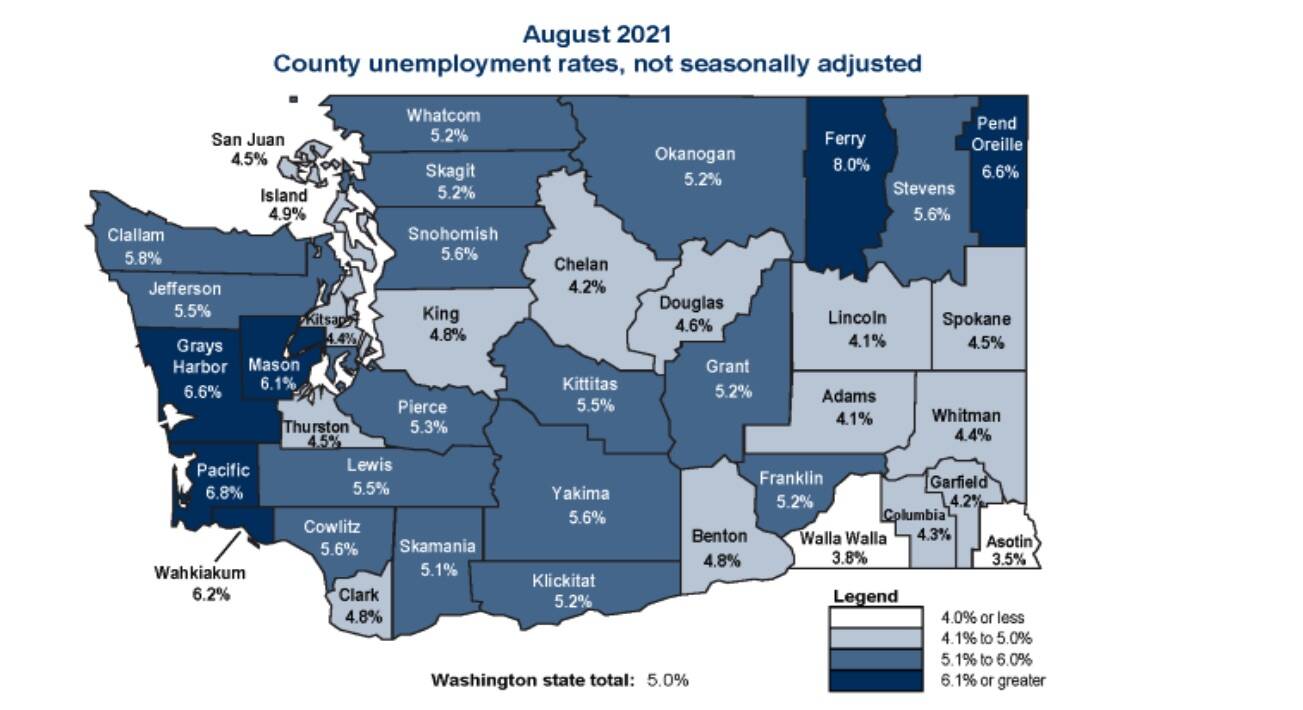King County’s economy is doing better than most as COVID-19 continues to ravage the state, according to Washington’s Employment Security Department (ESD) data.
As of August 2021, King County’s unemployment rate is 4.8% — lower than the state average of 5% — several factors contribute to the lower rate, said Anneliese Vance-Sherman, ESD regional economist.
“King County is the economic powerhouse of the state, there’s a lot of industrial diversity, a lot of different types of jobs which already makes it easier for people to connect depending on their skill set,” Vance-Sherman said. “We also have robust public transportation, redundant networks for transportation, social networks and just a density of people which lends itself to lower unemployment rates.”
The federal unemployment assistance program ended in early September, so it’s too soon to tell how that has and will affect the labor market, Vance-Sherman said.
Although the unemployment rate in King County is low, some industries are still facing labor shortages, due to a variety of factors, Vance-Sherman said.
During a normal recession, the demand for labor is low and people are laid off, but when the economy recovers, employers have no problem finding workers, Vance-Sherman said. What’s different this time is the pandemic; there are a number of reasons people aren’t working beyond the lack of available jobs.
One major factor of the labor shortage has been childcare, as schools went online and childcare facilities had to do social distancing, it became much harder for parents to find affordable, accessible childcare, Vance-Sherman said. This caused a lot of parents to stay home to watch their kids rather than work, however, now that school is back in-person and federal unemployment has cut off, things could change, Vance-Sherman said.
Another thing causing people to stay home is simply their health and safety as people are less willing to work when it could put their health, and the health of their family, at risk, Vance-Sherman said.
“All of these factors came in and so we’ve got the demand for labor increase, and we see that with increase in job listings, but the supply of labor is still being impacted by COVID to a greater extent,” Vance-Sherman said.
The industry hit the hardest throughout the pandemic is hospitality and leisure, which paid a national average of around $18 an hour in Aug. 2021 according to the Bureau of Labor Statistics.
Essentially, the demand for labor recovered faster than the willingness to work for low wages during a deadly global pandemic.
Employers in King County and across the state are facing two challenges, Vance-Sherman said. The first is digging themselves out of the hole caused by the lockdowns and low demand for goods and services that occurred in the beginning of the pandemic. The second challenge is finding people willing to do the work.
The shortage of workers during this pandemic-fueled recession is similar to shortages that occur when the economy is strong, Vance-Sherman said. Because the demand for workers is higher than the demand for jobs, workers could have a bit of an advantage.
In order to make jobs more appealing to workers, employers may start to offer better wages, more flexible hours and other benefits, Vance-Sherman said. The Department of Employment Security Department has already seen anecdotal evidence of this.
Although King County as a whole is doing better than most counties in the state, residents in south King County aren’t doing as well as their north King County counterparts, Vance-Sherman said.
For example, Auburn’s unemployment rate as of August is 6.2%, a full percent higher than King County’s as a whole. Communities in south King County typically have higher unemployment rates than communities in north King County, Vance-Sherman said.
This has to do with the cost of living in the two parts of King County, Vance-Sherman said. The cost of housing in Seattle and much of north King County is higher than in south King County. So people who live in north King County tend to have higher paying jobs and are more likely to be able to work from home, reducing the unemployment rate.
However in south King County, where housing is more affordable, there are more people who work in lower paying industries that were hit harder by the pandemic, Vance-Sherman said. This leads to a higher unemployment rate in south King County communities.
This is reflected not only in the current unemployment rate in cities like Auburn, but also the peak unemployment rates in 2020, Vance-Sherman said. The peak unemployment rate in Auburn during 2020 was 18% compared to King County’s peak of 15.1%.
The good news is that unemployment rates across the county are nowhere near what they were during the spring months of 2020. However, the ever-changing nature of the COVID-19 pandemic makes it difficult to predict what will happen in the future.
To learn more about the state of Washington’s economy, visit the Employment Security Department’s website.


